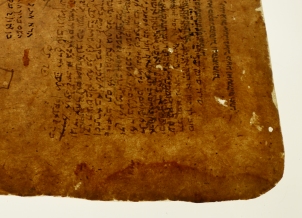As part of our ongoing project to conserve the Hebrew collection, I’ve just completed the conservation of 19 folios from a Hebrew Yemenite Pentateuch.
The Pentateuch is formed of the first five books of the Hebrew Bible and is central to the Judaic religious tradition. This manuscript was copied in the Yemen, at the southern end of the Arabian Peninsula. There was once a large Jewish community in this region, although it is now a predominantly Muslim country.
CBL Heb 761 consists of 353 folios in total and was thought to have dated from the 13th century. However, Dr Ben Outhwaite, Head of the Taylor-Schechter Genizah Research Unit at Cambridge University Library, thinks it’s actually more likely to be a 15th century object. Either way, this codex is the earliest manuscript on paper in the CBL Hebrew collection.

The main body of the textblock H255mm x W195mm x D67mm
This robustly proportioned manuscript is in very poor condition, and cannot be handled, displayed or digitised. The paper -especially at the spine- has been extensively damaged, and the binding is missing entirely. A combination of water and insect damage has caused the spine area to block together making it extremely difficult to read the text without incurring further damage to the paper. An initial condition assessment estimated that full paper repair alone would take approximately 350 hours.

Folios 335-353 before treatment
However, the last few quires of the textblock were in marginally better condition and had been sewn together with crude modern stab sewing. For this reason it was proposed that this section of the manuscript would undergo treatment as a test case for the rest of the object. This would also allow part of the item to be displayed and undergo research.
Folios 335 to 353 had been over-sewn with a thin modern linen thread. A number of earlier sewing holes were clearly visible and the paper was stained in places, especially at the spine. Every edge had suffered tears and losses due to water, insect, and rodent damage.

An encyclopedia of pest damage: silverfish or book louse grazing; rodent teeth marks; and larvae holes

A folio in transmitted light, showing the many raw fibre inclusions throughout the sheet.
In spite of the diverse damages to this manuscript, the paper revealed itself as a beautiful and high-quality material. It was made using a flexible mould screen, leaving little evidence of chain or laid lines, and had been prepared with a surface size and heavy burnishing. The characteristic glossy and hard burnished surface was still visible across the folios. On assessment with transmitted light, inclusions of unprocessed material were visible showing that the paper was not made using rags, but raw plant fibre stock. The sheet formation and preparation techniques are typical of the Arabian Peninsula region, and would usually be described as Islamic.

Evidence of paper preparation: striations from drying or polishing; and the smooth sheen of the finished burnished paper surface.
Once the modern stab sewing was fully documented, it was removed to allow treatment of the folios. Each of the 19 individual folios was assessed and any evidence of collation, such as sewing holes, remnants of threads, and fragmentary spine folds was recorded with a thorough collation map. The folios were then gently surface cleaned with a soft brush to remove any loose accretions, before localised application of a chemical sponge to remove heavier surface dirt. These gentle techniques are effective, whilst still preserving the sized and burnished surface of the paper. Finally the folios could be repaired using a combination of toned handmade Japanese papers and wheat starch paste.

Finished paper repairs, ready for very careful trimming.
Repair was slow, taking almost one day per folio, but dramatically improved both the appearance and stability of the folios. Once complete, the folios were realigned and the repairs were trimmed. For further protection and ease of handling and display, the three fragmentary quires were resewn with a link stitch at two stations, and rehoused in a simple cotton-covered binding. This fascinating manuscript is truly a multicultural object. Written in Hebrew, it is a Jewish religious text produced in Yemen using local Islamic materials and techniques. It embodies the cultural and religious diversity of this period and the region, and its long-established history as a vibrant centre for trade.
This fascinating manuscript is truly a multicultural object. Written in Hebrew, it is a Jewish religious text produced in Yemen using local Islamic materials and techniques. It embodies the cultural and religious diversity of this period and the region, and its long-established history as a vibrant centre for trade.
Kristine Rose Beers, Senior Conservator
More information about Kristine’s work, including her recent trip to Doha, can be found on her personal blog.
Fantastic work Kristine! I hope to publish on Yemenite bindings with the John Rylands research institute next year…we should exchange notes! You’re so knowledgeable! Have a lovely Christmas, Laura
LikeLike
Thanks so much, Laura! I’m glad you enjoyed the post.
LikeLike
Pingback: Conservation through generations | Chester Beatty Conservation